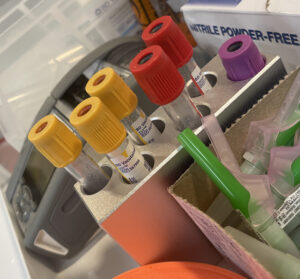Attention Lab Personnel
Management, Staff, Phlebotomists, Lab Tech’s
Please know this patient is known to have or suspected to have, Cold Agglutinin Disease. Or has had problems in the past with blood “Agglutination” causing a CBC/RBC to fail to result. Or results that may have been inaccurate.
Specifically, problems trying to result an accurate Hgb.
There are other types of specialty tests that may be affected too. Tests that typically deal with Red Blood Cell counts, their size, or structure.
Many routine blood tests are un-affected by the agglutination that occurs. Many can be processed using standard protocols.
This is mainly to advise of the known problems with a CBR/RBC. Other tests impacted by Cold Agglutinin Disease should be known by Management Staff/Lab supervisors. This is to avoid numerous unnecessary re-draws or delays when testing fails to result.
If you are unaware of this disease or the need to provide special handling during some specific blood tests. Please inform your management “in charge” before drawing. The Lab Tech’s must be on board too.
Some patients having a higher level of Cold Agglutinin Disease, where “Agglutination” starts immediately after being drawn at body temperature. Require “Warming techniques” to maintain the blood sample temperature through its chain of custody and completion of testing.
Meaning the tubes need prewarmed, then samples kept warmed during the entire draw process including delivery to the lab, and lab testing Stat. To prevent Agglutination from occurring.
Not testing “Stat” will most likely cause a failed or incorrect result. Attempting to rewarm the sample in the lab after agglutination occurs is mostly not successful, or results may not be accurate.
Various warming methods are used. One is preferred. Prewarming the tubes, then preferably placing them in a prewarmed “Block Warmer” for transport to an on-site lab, then tested “STAT”. We often see the phlebotomist use a pre-heated tube “block warmer”, at the City of Hope. See image below.
We have witnessed other warming method attempts. These may or may not be as successful all the time. Much depends on the patient’s cold sensitivity level.
Methods such as wrapping the sample tubes in chemical heat packs/Baby “heel warmers”, warm water immersion baths with a thermometer, etc.
Though we have seen all of these used. These latter methods (Non-Block warmer methods), often fail on high reactive/cold sensitive Cold Agglutinin Disease patients. Any time it is difficult to maintain samples at 37°C during the entire process.
A facility suggesting “in the bra or under an armpit” type of mentality to keep it warm during transport to the lab. Is pathetically unprepared and frankly unprofessional. Suggesting lack of knowledge, training, and sub-standard patient care.
If at a satellite collection location. Where samples are collected, then transported to an off-site lab via a courier. The patient needs advised they may need to have their CBC/RBC draw/collection done at the lab site location. Which may include some tests other than the CBC/RBC.

For Collection, Transport, and Lab
To maintain the sample at 37°C
Patient Name: _______________________________________
Doctor/Hematologist _________________________________
Dr Address __________________________________________
Dr Address __________________________________________
Dr Contact Tel # _________________________________
![]()
